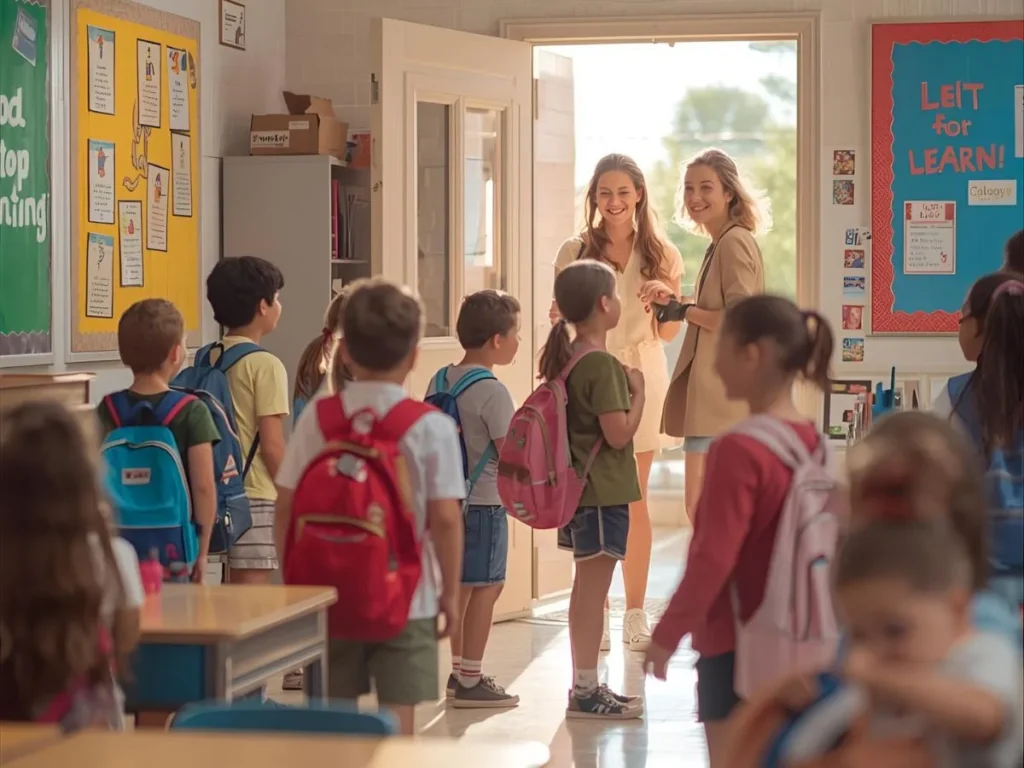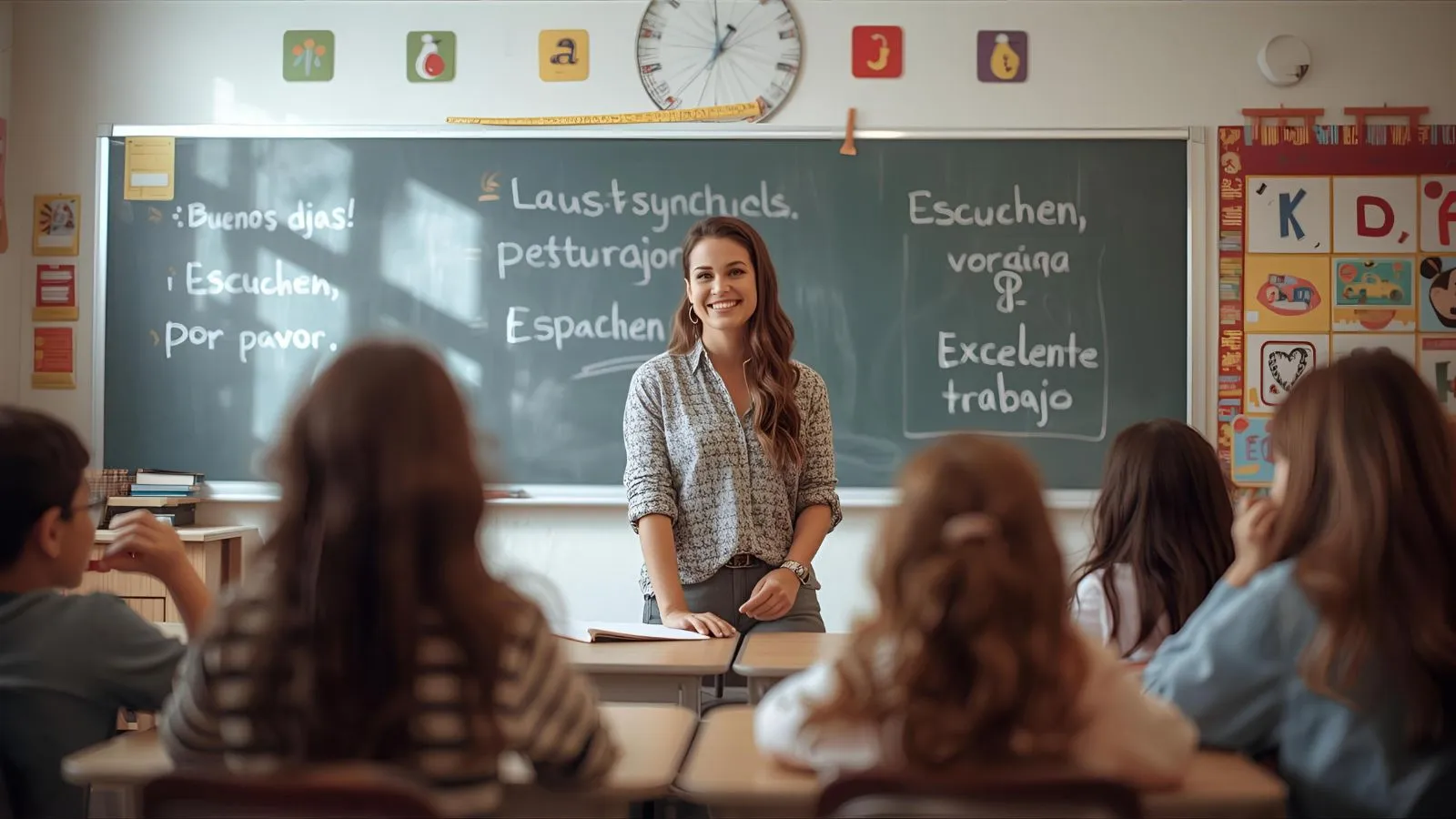If you’re a teacher and you’ve ever had Spanish-speaking students in your classroom, I bet you’ve thought at least once, “I wish I knew a few Spanish phrases so I could connect better with my students.”
Right? 😊
These days, classrooms are more diverse than ever, and communication isn’t limited to English anymore. Even saying something simple like “¡Buenos días!” (Good morning) or “Excelente trabajo!” can bring a big smile to your students’ faces.
In this article, we’ll explore some useful Spanish phrases for teachers that will help you feel more confident, build stronger connections, and create a welcoming atmosphere in your classroom.
Simple, practical, and perfect for everyday use!
Why It Matters
Knowing Spanish phrases for teachers is a practical skill that bridges culture and communication. Many schools today have bilingual or multilingual classrooms, where students speak both English and Spanish at different levels. Teachers who can use even simple Spanish phrases show empathy and awareness.
Imagine telling a shy student “Buen trabajo” (Good job) or greeting a parent with “Gracias por su colaboración” (Thank you for your cooperation). These moments create warmth and trust.
It’s not just about language—it’s about connection. Using Spanish classroom phrases also helps keep lessons smooth. If a student doesn’t understand “Take out your notebook,” saying “Saca tu cuaderno” can make instructions clear instantly.
From giving directions to motivating learners, Spanish phrases for teachers make communication stronger, classroom management easier, and relationships more meaningful.
🗂️ Classroom Greetings & Daily Routines

Buenos días / Buenas tardes
Explanation: Common greetings to start class or welcome students.
Use When: At the start of the day or when students enter the classroom.
Example: “Buenos días, clase. Vamos a empezar.”
Por favor, siéntense / Levántense, por favor
Explanation: Instructions to sit or stand.
Use When: During transitions between lessons or activities.
Example: “Por favor, siéntense y abran sus libros.”
¿Listos? / Estamos listos
Explanation: Asking if everyone is ready.
Use When: Before beginning a new task or activity.
Example: “¿Listos? Bien, empecemos con el juego.”
Es hora de…
Explanation: Signals a transition in the class routine.
Use When: Moving from one activity to another.
Example: “Es hora de leer. Saquen sus cuadernos.”
Hasta mañana / Adiós
Explanation: Ending class with a friendly goodbye.
Use When: At the end of the school day.
Example: “Muy bien hoy. Hasta mañana, clase.”
✅ Comprehension & Checking Understanding

¿Comprendes? / No comprendo
Explanation: Checking for understanding or clarifying confusion.
Use When: After giving instructions.
Example: “¿Comprenden lo que vamos a hacer?”
¿Puedes repetir, por favor?
Explanation: Asking for repetition.
Use When: When you or a student needs clarification.
Example: “¿Puedes repetir la pregunta, por favor?”
Más despacio, por favor
Explanation: Requesting to slow down speech.
Use When: When students are struggling to follow along.
Example: “Voy a explicar otra vez, más despacio, por favor.”
¿Cómo se dice ___ en español?
Explanation: Encouraging vocabulary learning.
Use When: Teaching new words.
Example: “¿Cómo se dice ‘pencil’ en español?”
¿Tienes una pregunta?
Explanation: Encourages questions and interaction.
Use When: After a lesson or explanation.
Example: “¿Tienen alguna pregunta antes de empezar el ejercicio?”
🎒 Instructions & Classroom Management
Escúchame / ¡Oye!
Explanation: To get students’ attention.
Use When: When starting new instructions.
Example: “Escúchame, por favor. Vamos a la página diez.”
Levántate / Siéntate
Explanation: Commands for moving or sitting.
Use When: Switching between activities.
Example: “Levántate y forma un círculo aquí.”
Toma tu tiempo
Explanation: Encouraging patience and focus.
Use When: During independent work or tests.
Example: “Toma tu tiempo. No te preocupes.”
No hables / Atención
Explanation: Regaining order or quiet.
Use When: When students get noisy.
Example: “No hablen, por favor. Atención en mí.”
Haz tu tarea / Abre el libro a la página…
Explanation: Common classroom instructions.
Use When: Assigning homework or directing reading.
Example: “Haz tu tarea para mañana.”
💬 Feedback & Encouragement
¡Buen trabajo!
Explanation: Expresses praise for effort.
Use When: A student completes a task well.
Example: “¡Buen trabajo hoy, chicos!”
Estás mejorando
Explanation: Recognizes improvement over time.
Use When: When progress is visible.
Example: “Estás mejorando mucho. Sigue así.”
Puedes hacerlo mejor
Explanation: Encourages further effort.
Use When: Offering constructive feedback.
Example: “Lo lograste, pero puedes hacerlo mejor.”
No te preocupes / Todo está bien
Explanation: Reduces student anxiety.
Use When: After mistakes or tough moments.
Example: “No te preocupes, todo está bien.”
Gracias por tu esfuerzo
Explanation: Shows appreciation for hard work.
Use When: At the end of lessons or projects.
Example: “Gracias por tu esfuerzo hoy.”
🌍 Parent & Family Communication

Bienvenido(a) a nuestra clase
Explanation: Greeting parents warmly.
Use When: At meetings or open house events.
Example: “Bienvenido a nuestra clase.”
¿Cómo está su hijo(a)?
Explanation: Asking about a student’s wellbeing.
Use When: During conferences or check-ins.
Example: “¿Cómo está su hijo en casa?”
Su hijo(a) necesita apoyo en…
Explanation: Communicating academic needs.
Use When: Sharing progress reports.
Example: “Su hijo necesita apoyo en lectura.”
Gracias por su colaboración
Explanation: Expresses gratitude to families.
Use When: After home-school efforts.
Example: “Gracias por su colaboración.”
Nos reunimos pronto
Explanation: Scheduling a future meeting.
Use When: Planning follow-up discussions.
Example: “Nos reunimos pronto para hablar del progreso.”
🧠 Student Motivation & Inclusion

Eres capaz
Explanation: Reinforces self-belief.
Use When: When students feel unsure.
Example: “Eres capaz. Inténtalo una vez más.”
Tu voz importa
Explanation: Validates student opinions.
Use When: Encouraging participation.
Example: “Tu voz importa en esta clase.”
Aquí todos aprendemos
Explanation: Promotes inclusivity.
Use When: Setting class culture.
Example: “Aquí todos aprendemos juntos.”
Cada intento cuenta
Explanation: Encourages persistence.
Use When: During practice or group work.
Example: “Cada intento cuenta, no te rindas.”
Celebremos el progreso
Explanation: Celebrates growth and teamwork.
Use When: Ending a unit or project.
Example: “Celebremos el progreso de todos hoy.”
🗣️ Bonus Category: Phrases for Emergencies or Quick Help
¿Estás bien?
Explanation: Checking a student’s wellbeing.
Use When: After an accident or if a child looks upset.
Example: “¿Estás bien? ¿Necesitas ayuda?”
Espera un momento
Explanation: Asking a student to wait.
Use When: Handling multiple requests.
Example: “Espera un momento, por favor.”
Necesito ayuda / Ayúdame, por favor
Explanation: Asking or teaching to ask for help.
Use When: In emergency or during collaborative activities.
Example: “Si necesitas ayuda, di ‘Ayúdame, por favor’.”
Sal con cuidado
Explanation: Safety direction for leaving the room.
Use When: During recess, drills, or dismissal.
Example: “Sal con cuidado y espera afuera.”
Tranquilo(a), todo está bien
Explanation: Calming anxious or emotional students.
Use When: During emotional moments.
Example: “Tranquilo, todo está bien.”
Final Thoughts
In conclusion, learning and using Spanish phrases for teachers helps build strong relationships, smoother lessons, and a sense of belonging. You don’t need to be fluent—just consistent. Every “Buenos días” or “Buen trabajo” shows care, effort, and inclusion.
Start small: choose a few greetings, some classroom management phrases, and a couple of encouraging ones. Use them daily. Over time, your confidence and your students’ smiles will grow. Remember, teaching isn’t just about words—it’s about connection. And with these Spanish phrases for teachers, you’ll connect in ways that truly matter.
Bonus Recap Table
| Category | Example Phrase | Use When |
|---|---|---|
| Greetings & Routines | Buenos días, ¿Listos? | At the start of class |
| Comprehension | ¿Comprendes?, Más despacio | During explanations |
| Classroom Management | Escúchame, Haz tu tarea | To guide student behavior |
| Feedback | ¡Buen trabajo!, Estás mejorando | During assessment or praise |
| Parent Communication | Gracias por su colaboración | After meetings or notes home |
| Motivation | Eres capaz, Tu voz importa | To inspire or include students |
| Emergencies | ¿Estás bien?, Tranquilo | For safety or calm situations |

At QuickReply.com, speed meets smart communication! Instantly craft perfect replies, boost engagement, and save time. Your go-to hub for quick, witty, and professional message responses anytime!

Leave a Reply